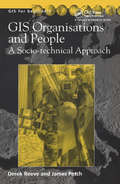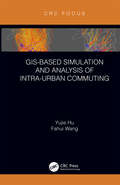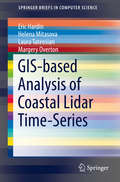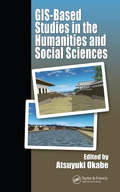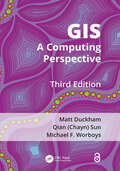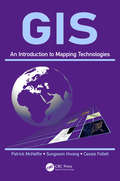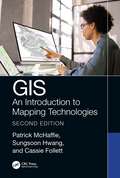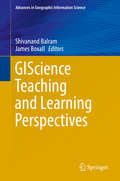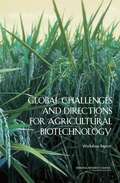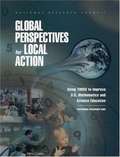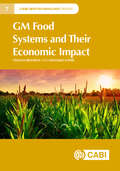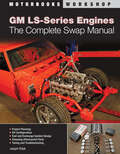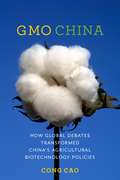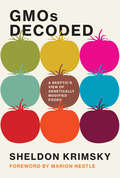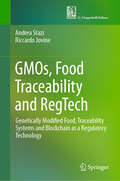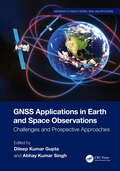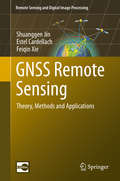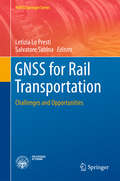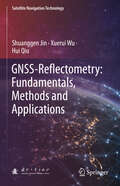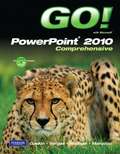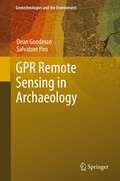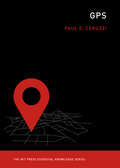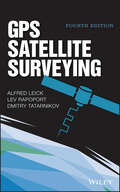- Table View
- List View
GIS, Organisations and People: A Socio-technical Approach
by James PetchGIS projects have previously been viewed primarily as technical exercises but it is now evident that the success of GIS projects depends as much upon organisational issues as upon technicalities. GIS projects have socio-organisational contexts which must be taken into account if such projects are to succeed. The book presents an overview of the "human" side of GIS, both individual and organisational.
GIS-Based Simulation and Analysis of Intra-Urban Commuting
by Yujie Hu Fahui WangCommuting, the daily link between residences and workplaces, sets up the complex interaction between the two most important land uses (residential and employment) in a city, and dictates the configuration of urban structure. In addition to prolonged time and stress for individual commuters on traffic, commuting comes with additional societal costs including elevated crash risks, worsening air quality, and louder traffic noise, etc. These issues are important to city planners, policy researchers, and decision makers. GIS-Based Simulation and Analysis of Intra-Urban Commuting, presents GIS-based simulation, optimization and statistical approaches to measure, map, analyze, and explain commuting patterns including commuting length and efficiency. Several GIS-automated easy-to-use tools will be available, along with sample data, for readers to download and apply to their own studies. This book recognizes that reporting errors from survey data and use of aggregated zonal data are two sources of bias in estimation of wasteful commuting, it studies the temporal trend of intraurban commuting pattern based on the most recent period newly-available 2006-2010, and it focuses on commuting, and especially wasteful commuting within US cities. It includes ready-to-download GIS-based simulation tools and sample data, and an explanation of optimization and statistical techniques of how to measure commuting, as well as presenting a methodology that can be applicable to other studies. This book is an invaluable resource for students, researchers, and practitioners in geography, urban planning, public policy, transportation engineering, and other related disciplines.
GIS-based Analysis of Coastal Lidar Time-Series
by Eric Hardin Helena Mitasova Laura Tateosian Margery OvertonThis SpringerBrief presents the principles, methods, and workflows for processing and analyzing coastal LiDAR data time-series. Robust methods for computing high resolution digital elevation models (DEMs) are introduced as well as raster-based metrics for assessment of topographic change. An innovative approach to feature extraction and measurement of feature migration is followed by methods for estimating volume change and sand redistribution mapping. Simple methods for potential storm impacts and inundation pattern analysis are also covered, along with visualization techniques to support analysis of coastal terrain feature and surface dynamics. Hands-on examples in GRASS GIS and python scripts are provided for each type of analysis and visualization using public LiDAR data time-series. GIS-based Analysis of Coastal Lidar Time-Series is ideal for professors and researchers in GIS and earth sciences. Advanced-level students interested in computer applications and engineering will also find this brief a valuable resource.
GIS-based Studies in the Humanities and Social Sciences
by Atsuyuki OkabeStudies in the humanities and the social sciences can be enhanced through the use of geographic information systems (GIS). However, this computer-aided method of analysis is worthless unless researchers can devote the time necessary to learn what it is, what it can do, and how to use it.Resulting from a six-year project entitled Spatial Inf
GIS: A Computing Perspective
by Matt Duckham Michael F. Worboys Qian (Chayn) SunFollowing two successful editions, the third edition of GIS: A Computing Perspective has been completely revised and updated, with extensive new content reflecting the significant progress that has been made in the realm of GIS within the last 20 years. Major new topics covered for the first time in this edition include: graph databases and graph query languages, ontology engineering and qualitative spatial reasoning, geosensor networks and GeoAI, decentralized computing and online algorithms, and critical GIS and data sovereignty. Features Includes an entirely new chapter on AI and GIS, including ontologies and the Semantic Web, knowledge representation (KR) and spatial reasoning, machine learning and spatial analysis, and neural networks and deep learning Presents new material reflecting the advances made in cloud computing, stream computing, and sensor networks, as well as extensively revised and updated content on cartography, visualization, and interaction design Connects the technology to the social aspects and implications of GIS, including privacy and fair information practices, FATE (fairness, accountability, transparency, and ethics), and codes of conduct for responsible use of GIS Integrates the necessary background to foundational areas, such as databases and data structures, algorithms and indexes, and system architecture and AI, provided in context so readers new to those topics can still understand the concepts being discussed Incorporates over 20 carefully explained spatial algorithms; over 60 inset boxes with in-depth material that enriches the central topics; and more than 300 color figures to support the reader in mastering key concepts Welcomes a new coauthor, Qian (Chayn) Sun, to the third edition, who brings her expertise in topics such as web mapping, cloud computing, critical geography, and machine learning with big spatial data Intended for anyone interested in understanding GIS, especially students taking upper-level undergraduate and graduate courses in computer science and geography, as well as academics, researchers, practitioners, and professionals working in the field and involved in advanced GIS projects.
GIS: An Introduction to Mapping Technologies
by Patrick McHaffie Sungsoon Hwang Cassie FollettThe purpose of this textbook is to provide an accessible introduction to geotechnology for a wide range of students. The techniques and approaches to problem solving, project organization and management, and data visualization are used with the intension of introducing students to the possibility of using GIS as a platform for making contributions to a wide range of programs that are concerned with social, economic, political, and environmental change. Includes activities that lead students through hands-on workflows to create flexible and functional "solutions" to specific tasks that are typical for geospatial analysts.
GIS: An Introduction to Mapping Technologies, Second Edition
by Patrick McHaffie Sungsoon Hwang Cassie FollettThe second edition of this introductory GIS textbook is thoroughly rewritten and updated to respond to the demand for critical engagement with technologies that address relevant issues across several disciplines preparing students for higher-level work in geotechnologies. Chapters are arranged to (1) build competence in fundamental skills, (2) explore applications of higher-level managerial and analytical functions that are typically called upon in public, nonprofit, and private sector milieu, and (3) propose and detail a template for organizing, executing, and completing a GIS project successfully. This interests all users from beginners to experienced professionals. Features: Uses the latest version of ArcGIS Pro (3.0) to present a fully rewritten and updated text with diverse perspectives. Includes many real-world examples with urban planning, environmental, and social justice foci. Presents new discussions, examples, and lab materials on open-source GIS projects. Junior and senior level undergraduate students taking courses in remote sensing and GIS applications, studying in the fields of Geography, Environmental Sciences, Computer Science, Urban Studies, Public Health, and Social Disciplines, as well as researchers and academics in the same fields, will all benefit from the information provided in the updated version of this book.
GIScience Teaching and Learning Perspectives (Advances in Geographic Information Science)
by Shivanand Balram James BoxallThis volume uniquely links educational theories and the practice of GIScience in higher education contexts to guide classroom practice, present effective practical implementations from peers, and provide resources and strategies for effective teaching methods. The book offers a comprehensive exploration of GIScience education, including current trends and future educational needs in GIScience, and will act as a resource to prepare learners for a world that demands more intensive investment in present-day education and technological literacy. Additionally, the indirect benefit of merging the fragmented literature on GIScience literacy will provide a basis to examine common techniques and enable a new wave of research more rooted in learning theories. In ten chapters, the book is designed to attract an audience from geographic information systems science, geomatics, spatial information science, cartography, information technology, and educational technology as focus disciplines.
GLOBAL CHALLENGES AND DIRECTIONS FOR AGRICULTURAL BIOTECHNOLOGY: Workshop Report
by National Research Council of the National AcademiesMany developing countries are exploring whether biotechnology has a role in addressing national issues such as food security and environmental remediation, and are considering whether the putative benefits of the technology—for example, enabling greater agricultural productivity and stability in the food supply—outweigh concerns that the technology might pose a danger—to biodiversity, health, and local jobs. Some policy leaders worry that their governments are not prepared to take control of this evolving technology and that introducing it into society would be a risky act. Others have suggested that taking no action carries more risk, given the dire need to produce more food. This book reports on an international workshop held to address these issues. Global Challenges and Directions for Agricultural Biotechnology: Mapping the Course, organized by the National Research Council on October 24-25, 2004, in Washington, DC, focused on the potential applications of biotechnology and what developing countries might consider as they contemplate adopting biotechnology. Presenters at the workshop described applications of biotechnology that are already proving their utility in both developing and developed countries.
GLOBAL PERSPECTIVES for LOCAL ACTION: Using TIMSS to Improve U.S. Mathematics and Science Education
by Committee on Science Education K-12The National Academies Press (NAP)--publisher for the National Academies--publishes more than 200 books a year offering the most authoritative views, definitive information, and groundbreaking recommendations on a wide range of topics in science, engineering, and health. Our books are unique in that they are authored by the nation's leading experts in every scientific field.
GM Food Systems and Their Economic Impact (CABI Biotechnology Series)
by Dr Tatjana Brankov Dr Koviljko LovreThe development of transgenic crops is revolutionary, but what does it mean for food production, prices and the environment? This is the first book to examine the economic evidence in a methodical way. It initially describes the historical evolution of biotechnology and defines key terms, before moving on to explore transgenic technology and food regime concepts. The book analyzes genetically modified organism (GMO) policy as part of overall agrarian policy, considering neoregulation in the USA, the EU, Brazil, Russia, China, India, South Africa and Serbia; as well as discussing agricultural performance, support and trade relations. The effect of transgenic food production on world food prices is also examined, along with food security at global and regional levels, and the links between GMOs and world hunger. The environmental implications of transgenic technology are considered through analysis of pesticide and fertilizer usage and efficiency, and pesticide consumption in GMO and non-GMO producing countries. Finally, the book considers the entry of transgenic ingredients into the food chain and lists the products affected. Key features: - Detailed analysis of economic data. - Comparison of international trends, including BRICS countries (Brazil, Russia, India, China and South Africa) and Serbia. - Evaluation of environmental and food security implications. - Glossary of important terms. This book will be valuable for agricultural economists, including students at Masters and PhD level. It will also be of interest to agricultural engineers, food technologists, nutritionists, industry representatives, policy makers, policy advisers and analysts and NGOs.
GM Food Systems and Their Economic Impact (CABI Biotechnology Series)
by Dr Tatjana Brankov Dr Koviljko LovreThe development of transgenic crops is revolutionary, but what does it mean for food production, prices and the environment? This is the first book to examine the economic evidence in a methodical way. It initially describes the historical evolution of biotechnology and defines key terms, before moving on to explore transgenic technology and food regime concepts. The book analyzes genetically modified organism (GMO) policy as part of overall agrarian policy, considering neoregulation in the USA, the EU, Brazil, Russia, China, India, South Africa and Serbia; as well as discussing agricultural performance, support and trade relations. The effect of transgenic food production on world food prices is also examined, along with food security at global and regional levels, and the links between GMOs and world hunger. The environmental implications of transgenic technology are considered through analysis of pesticide and fertilizer usage and efficiency, and pesticide consumption in GMO and non-GMO producing countries. Finally, the book considers the entry of transgenic ingredients into the food chain and lists the products affected. Key features: - Detailed analysis of economic data. - Comparison of international trends, including BRICS countries (Brazil, Russia, India, China and South Africa) and Serbia. - Evaluation of environmental and food security implications. - Glossary of important terms. This book will be valuable for agricultural economists, including students at Masters and PhD level. It will also be of interest to agricultural engineers, food technologists, nutritionists, industry representatives, policy makers, policy advisers and analysts and NGOs.
GM LS-Series Engines: The Complete Swap Manual (Motorbooks Workshop)
by Joseph PotakIn this illustrated guide, an LS-series expert takes you step-by-step through the process of installing GM’s high-power engines in any automobile.First underhood in the 1997 Corvette, GM’s LS engines have proven powerful, reliable, and amazingly fuel efficient. Since that time, more than a dozen variants have been produced, ranging from bulletproof, iron-block 4.8-liter workhorses to the supercharged 7.0-liter LS7. Among performance enthusiasts, these remarkable V-8 engines have become a favorite for engine swaps, owing to their fantastic power, compact design, and modification possibilities.In GM LS-Series Engines: The Complete Swap Manual, professional LS-series engine specialist and technician Joseph Potak details all the considerations involved in performing this swap into any vehicle. With clear instructions, color photos, diagrams, and specification tables, Potak guides you through:Mounting your new engineConfiguring the EFI systemDesigning fuel and exhaust systemsSourcing the correct accessories for your applicationTransmission, torque converters, and clutchesPerformance upgrades and power-addersTroubleshooting, should problems arise
GMO China: How Global Debates Transformed China's Agricultural Biotechnology Policies (Contemporary Asia in the World)
by Cong CaoIn China, as elsewhere, the debate over genetically modified organisms has become polarized into anti- and pro-GMO camps. Given the size of China’s population and market, much is at stake in conflicts over regulation for domestic as well as international actors. In this book, Cong Cao provides an even-handed analysis that illuminates the tensions that have shaped China’s policy toward agricultural biotechnology in a global perspective.Cao presents a comprehensive and systematic analysis of how China’s policy toward research and commercialization of genetically modified crops has shifted that explains how China’s changing GMO stances reflect its evolving position on the world stage. While China’s scientific community has set the agenda, it has encountered resistance rooted in concerns over food safety and consumers’ rights as well as issues of intellectual property rights and food sovereignty. Although Chinese leaders at first sought to take advantage of the biotech revolution by promoting GMO crop consumption, Cao demonstrates that policy has since become precautionary, as seen in new laws and regulations grounded in concerns over safety and the deferral of commercialization of GM rice. He presents China’s policies in light of changing global attitudes toward GM crops: As shifts in China have closely followed global trends, so has domestic activism. Drawing on government and scientific documents as well as interviews with scientists, officials, policy analysts, activists, and journalists, GMO China is an important book for China studies, science and technology studies, policy analysts, and professionals interested in the Chinese biotechnology market.
GMOs Decoded: A Skeptic's View of Genetically Modified Foods (Food, Health, and the Environment)
by Sheldon KrimskyThe debate over genetically modified organisms: health and safety concerns, environmental impact, and scientific opinions.Since they were introduced to the market in the late 1990s, GMOs (genetically modified organisms, including genetically modified crops), have been subject to a barrage of criticism. Agriculture has welcomed this new technology, but public opposition has been loud and scientific opinion mixed. In GMOs Decoded, Sheldon Krimsky examines the controversies over GMOs—health and safety concerns, environmental issues, the implications for world hunger, and the scientific consensus (or lack of one). He explores the viewpoints of a range of GMO skeptics, from public advocacy groups and nongovernmental organizations to scientists with differing views on risk and environmental impact.Krimsky explains the differences between traditional plant breeding and “molecular breeding” through genetic engineering (GE); describes early GMO products, including the infamous Flavr Savr tomato; and discusses herbicide-, disease-, and insect-resistant GE plants. He considers the different American and European approaches to risk assessment, dueling scientific interpretations of plant genetics, and the controversy over labeling GMO products. He analyzes a key 2016 report from the National Academies of Sciences on GMO health effects and considers the controversy over biofortified rice (Golden Rice)—which some saw as a humanitarian project and others as an exercise in public relations. Do GMO crops hold promise or peril? By offering an accessible review of the risks and benefits of GMO crops, and a guide to the controversies over them, Krimsky helps readers judge for themselves.
GMOs, Food Traceability and RegTech: Genetically Modified Food, Traceability Systems and Blockchain as a Regulatory Technology
by Andrea Stazi Riccardo JovineThe book deals with the regulation of GMOs within the context of multiple principles and interests, including food security, sustainable development, and biodiversity. The recognition of intellectual property rights, particularly with respect to geographical indications and patentability is also discussed. From a comparative perspective, the importance of traceability in the food industry, driven by major world powers' consumer and market protection policies, is highlighted. Finally the use of emerging technologies, such as blockchain, as a form of "regulatory technology" for more effective and sustainable management of traceability systems within the food supply chain, is explored as a workable and forward looking solution.
GMP-Qualifizierung und Validierung von Wirkstoffanlagen: Ein Leitfaden für die Praxis
by Ralf GengenbachUnter Validierung bzw. Qualifizierung versteht man die Beweisf hrung, dass Verfahren, Prozesse, Ausr stungsgegenst nde, Materialien, Arbeitsg nge oder Systeme tats chlich zu den erwarteten Ergebnissen f hren. Betroffen sind alle Unternehmen, die Rohstoffe, Halbfertig- oder Fertigprodukte f r medizinische Ger te, Pharmazeutika, Diagnostika, Lebensmittel herstellen. Ebenso sind Labore betroffen, die Dienstleistungen anbieten, deren Ergebnisse direkt in den Herstellungsprozess einflie en. Dieses Buch liefert "harte Fakten" hinsichtlich der Durchf hrung (How to do) von praxiserprobten Qualifizierungs- und Validierungsma nahmen - ein "Must have" f r Wirkstoff- und Arzneimittelhersteller sowie deren Zulieferer. Der deutsche Titel zur Validierung und Qualifizierung
GNSS Applications in Earth and Space Observations: Challenges and Prospective Approaches (Microsatellite Remote Sensing, GNSS, and Applications)
by Abhay Kumar Singh Dileep Kumar GuptaGlobal Navigation Satellite Systems (GNSSs) have become an essential technology used in navigation, positioning, and timing applications in meteorology, environmental monitoring, disaster management, and space exploration. This comprehensive book explores the various applications of GNSS technology in different fields of Earth and Space observations and provides researchers, professionals, and students valuable insights into these emerging trends. It discusses the challenges that impact the performance of GNSS technology and offers solutions through several case studies on Space weather and climate disasters, opening a different dimension of approaches in various paradigms of GNSS technology.Features: Covers the most up-to-date GNSS applications in three major areas related to Earth and Space observations: climate studies, disaster management, and Space weather monitoring Includes case studies of best practices in climate studies and disaster management Explains the impacts of Space weather events on the near-Earth environment Describes limitations and future possibilities of better use of GNSS in Earth and Space observation and monitoring Highlights an integrated and interdisciplinary approach valuable to a wide range of readers studying Earth and Space interactions This book is a valuable resource for professionals, researchers, academics, and students in Remote Sensing and GIS, Earth Science, Physics and Electronics, Climate Studies, Disaster Management, Geophysics, and Space Science.
GNSS Remote Sensing
by Shuanggen Jin Estel Cardellach Feiqin XieThe versatile and available GNSS signals can detect the Earth's surface environments as a new, highly precise, continuous, all-weather and near-real-time remote sensing tool. This book presents the theory and methods of GNSS remote sensing as well as its applications in the atmosphere, oceans, land and hydrology. Ground-based atmospheric sensing, space-borne atmospheric sensing, reflectometry, ocean remote sensing, hydrology sensing as well as cryosphere sensing with the GNSS will be discussed per chapter in the book.
GNSS for Rail Transportation: Challenges And Opportunities (PoliTO Springer Series)
by Letizia Lo Presti Salvatore SabinaThis book proposes a general methodology to introduce Global Navigation Satellite System (GNSS) integrity, starting from a rigorous mathematical description of the problem. It highlights the major issues that designers need to resolve during the development of GNSS-based systems requiring a certain level of confidence on the position estimates. Although it follows a general approach, the final chapters focus on the application of GNSS integrity to rail transportation, as an example. By describing the main requirements in the context of train position function, one of which is the safe function of any train control system, it shows the critical issues associated with the concept of safe position integrity. In particular, one case study clarifies the key differences between the avionic domain and the railway domain related to the application of GNSS technologies, and identifies a number of railway-signaling hazards linked with the use of such technology. Furthermore, it describes various railway-signaling techniques to mitigate such hazards to prepare readers for the future evolution of train control systems, also based on the GNSS technology. This unique book offers a valuable reference guide for engineers and researchers in the fields of satellite navigation and rail transportation.
GNSS-Reflectometry: Fundamentals, Methods and Applications (Satellite Navigation Technology)
by Shuanggen Jin Xuerui Wu Hui QiuThis book gives comprehensive introduction to the fundamentals, methods and applications of GNSS-Reflectometry (GNSS-R), including GNSS-R history, GNSS reflection signal characteristics, ground-based GNSS multipath reflectometry, interference pattern technology, delay Doppler map, space-based GNSS-R theory, ocean altimetry, hydrological remote sensing, vegetation monitoring and cryosphere remote sensing, etc. It well presents the current status and the latest application progress in this field. The authors have been engaged in the research and application of GNSS-R for many years with achieving lots of original theoretical and application progress, such as GNSS-R scattering mechanism and new applications, which reflect the forefront trends and cutting-edge dynamics in this discipline. It has important reference value and application prospect for marine monitoring, environment remote sensing, global change monitoring, glacier and permafrost monitoring, meteorological and agricultural application and so on. This book is suitable for professionals, graduate students, and researchers engaged in satellite navigation, remote sensing, space geodesy, marine environment, meteorological services, and global change, and as well as technical support for engineers and transformation applications, especially those engaged in satellite navigation development and environmental remote sensing applications. The basis of English translation of this book, originally in Chinese, was facilitated by artificial intelligence. The content was later revised completely by the authors for accuracy.
GO! with Microsoft Powerpoint 2010, Comprehensive (GO!)
by Shelley Gaskin Alicia Vargas Donna Madsen Toni MaruccoFor introductory computer courses on Microsoft PowerPoint 2010 or courses in computer concepts with a lab component on PowerPoint. Teach the course YOU want in LESS TIME! The primary goal of the GO! Series, aside from teaching computer applications, is ease of implementation. This approach is based on clearly defined projects for students and a one-of-a-kind supplements package for instructors.
GPR Remote Sensing in Archaeology
by Dean Goodman Salvatore PiroGPR Remote Sensing in Archaeology provides a complete description of the processes needed to take raw GPR data all the way to the construction of subsurface images. The book provides an introduction to the "theory" of GPR by using a simulator that shows how radar profiles across simple model structures look and provides many examples so that the complexity of radar signatures can be understood. It continues with a review of the necessary radargram signal processes needed along with examples. The most comprehensive methodology to construct subsurface images from either coarsely spaced data using interpolation or from dense data from multi-channel equipment and 3D volume generation is presented, advanced imaging solutions such as overlay analysis are introduced, and numerous worldwide site case histories are shown. The authors present their studies in a way that most technical and non-technical users of the equipment will find essentials for implementing in their own subsurface investigations.
GPS (The MIT Press Essential Knowledge series)
by Paul E. CeruzziA concise history of GPS, from its military origins to its commercial applications and ubiquity in everyday life.GPS is ubiquitous in everyday life. GPS mapping is standard equipment in many new cars and geolocation services are embedded in smart phones. GPS makes Uber and Lyft possible; driverless cars won't be able to drive without it. In this volume in the MIT Press Essential Knowledge series, Paul Ceruzzi offers a concise history of GPS, explaining how a once-obscure space technology became an invisible piece of our infrastructure, as essential to modern life as electric power or clean water. GPS relays precise time and positioning information from orbiting satellites to receivers on the ground, at sea, and in the air. It operates worldwide, and its basic signals are free, although private companies can commodify the data provided. Ceruzzi recounts the origins of GPS and its predecessor technologies, including early aircraft navigation systems and satellites. He describes the invention of GPS as a space technology in the post-Apollo, pre-Space Shuttle years and its first military and commercial uses. Ceruzzi explains how the convergence of three major technological developments—the microprocessor, the Internet, and cellular telephony—enabled the development and application of GPS technology. Recognizing the importance of satellite positioning systems in a shifting geopolitical landscape—and perhaps doubting U.S. assurances of perpetual GPS availability—other countries are now building or have already developed their own systems, and Ceruzzi reports on these efforts in the European Union, Russia, India, China, and Japan.
GPS Satellite Surveying
by Alfred Leick Lev Rapoport Dmitry TatarnikovEmploy the latest satellite positioning tech with this extensive guide GPS Satellite Surveying is the classic text on the subject, providing the most comprehensive coverage of global navigation satellite systems applications for surveying. Fully updated and expanded to reflect the field's latest developments, this new edition contains new information on GNSS antennas, Precise Point Positioning, Real-time Relative Positioning, Lattice Reduction, and much more. New contributors offer additional insight that greatly expands the book's reach, providing readers with complete, in-depth coverage of geodetic surveying using satellite technologies. The newest, most cutting-edge tools, technologies, and applications are explored in-depth to help readers stay up to date on best practices and preferred methods, giving them the understanding they need to consistently produce more reliable measurement. Global navigation satellite systems have an array of uses in military, civilian, and commercial applications. In surveying, GNSS receivers are used to position survey markers, buildings, and road construction as accurately as possible with less room for human error. GPS Satellite Surveying provides complete guidance toward the practical aspects of the field, helping readers to: Get up to speed on the latest GPS/GNSS developments Understand how satellite technology is applied to surveying Examine in-depth information on adjustments and geodesy Learn the fundamentals of positioning, lattice adjustment, antennas, and more The surveying field has seen quite an evolution of technology in the decade since the last edition's publication. This new edition covers it all, bringing the reader deep inside the latest tools and techniques being used on the job. Surveyors, engineers, geologists, and anyone looking to employ satellite positioning will find GPS Satellite Surveying to be of significant assistance.
